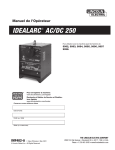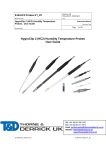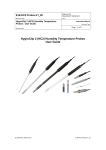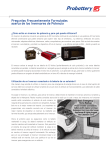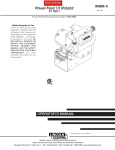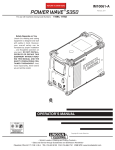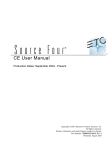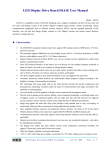Download Lincoln Electric IDEALARC IM402-B User's Manual
Transcript
RETURN TO MAIN MENU IDEALARC AC/DC 250 ® IM402-B August, 2007 For use with machines having Code Number 9491 thru 11104. Safety Depends on You Lincoln arc welding and cutting equipment is designed and built with safety in mind. However, your overall safety can be increased by proper installation ... and thoughtful operation on your part. DO NOT INSTALL, OPERATE OR REPAIR THIS EQUIPMENT WITHOUT READING THIS MANUAL AND THE SAFETY PRECAUTIONS CONTAINED THROUGHOUT. And, most importantly, think before you act and be careful. OPERATOR’S MANUAL Copyright © 2007 Lincoln Global Inc. • World's Leader in Welding and Cutting Products • • Sales and Service through Subsidiaries and Distributors Worldwide • Cleveland, Ohio 44117-1199 U.S.A. TEL: 216.481.8100 FAX: 216.486.1751 WEB SITE: www.lincolnelectric.com i i SAFETY WARNING CALIFORNIA PROPOSITION 65 WARNINGS Diesel engine exhaust and some of its constituents are known to the State of California to cause cancer, birth defects, and other reproductive harm. The Above For Diesel Engines The engine exhaust from this product contains chemicals known to the State of California to cause cancer, birth defects, or other reproductive harm. The Above For Gasoline Engines ARC WELDING CAN BE HAZARDOUS. PROTECT YOURSELF AND OTHERS FROM POSSIBLE SERIOUS INJURY OR DEATH. KEEP CHILDREN AWAY. PACEMAKER WEARERS SHOULD CONSULT WITH THEIR DOCTOR BEFORE OPERATING. Read and understand the following safety highlights. For additional safety information, it is strongly recommended that you purchase a copy of “Safety in Welding & Cutting - ANSI Standard Z49.1” from the American Welding Society, P.O. Box 351040, Miami, Florida 33135 or CSA Standard W117.2-1974. A Free copy of “Arc Welding Safety” booklet E205 is available from the Lincoln Electric Company, 22801 St. Clair Avenue, Cleveland, Ohio 44117-1199. BE SURE THAT ALL INSTALLATION, OPERATION, MAINTENANCE AND REPAIR PROCEDURES ARE PERFORMED ONLY BY QUALIFIED INDIVIDUALS. FOR ENGINE powered equipment. 1.h. To avoid scalding, do not remove the radiator pressure cap when the engine is hot. 1.a. Turn the engine off before troubleshooting and maintenance work unless the maintenance work requires it to be running. ____________________________________________________ 1.b. Operate engines in open, well-ventilated areas or vent the engine exhaust fumes outdoors. ____________________________________________________ 1.c. Do not add the fuel near an open flame welding arc or when the engine is running. Stop the engine and allow it to cool before refueling to prevent spilled fuel from vaporizing on contact with hot engine parts and igniting. Do not spill fuel when filling tank. If fuel is spilled, wipe it up and do not start engine until fumes have been eliminated. ____________________________________________________ 1.d. Keep all equipment safety guards, covers and devices in position and in good repair.Keep hands, hair, clothing and tools away from V-belts, gears, fans and all other moving parts when starting, operating or repairing equipment. ____________________________________________________ 1.e. In some cases it may be necessary to remove safety guards to perform required maintenance. Remove guards only when necessary and replace them when the maintenance requiring their removal is complete. Always use the greatest care when working near moving parts. ___________________________________________________ 1.f. Do not put your hands near the engine fan. Do not attempt to override the governor or idler by pushing on the throttle control rods while the engine is running. ELECTRIC AND MAGNETIC FIELDS may be dangerous 2.a. Electric current flowing through any conductor causes localized Electric and Magnetic Fields (EMF). Welding current creates EMF fields around welding cables and welding machines 2.b. EMF fields may interfere with some pacemakers, and welders having a pacemaker should consult their physician before welding. 2.c. Exposure to EMF fields in welding may have other health effects which are now not known. 2.d. All welders should use the following procedures in order to minimize exposure to EMF fields from the welding circuit: 2.d.1. Route the electrode and work cables together - Secure them with tape when possible. 2.d.2. Never coil the electrode lead around your body. 2.d.3. Do not place your body between the electrode and work cables. If the electrode cable is on your right side, the work cable should also be on your right side. 2.d.4. Connect the work cable to the workpiece as close as possible to the area being welded. ___________________________________________________ 1.g. To prevent accidentally starting gasoline engines while turning the engine or welding generator during maintenance work, disconnect the spark plug wires, distributor cap or magneto wire as appropriate. 2.d.5. Do not work next to welding power source. Mar ʻ95 ii ii SAFETY ARC RAYS can burn. ELECTRIC SHOCK can kill. 3.a. The electrode and work (or ground) circuits are electrically “hot” when the welder is on. Do not touch these “hot” parts with your bare skin or wet clothing. Wear dry, hole-free gloves to insulate hands. 3.b. Insulate yourself from work and ground using dry insulation. Make certain the insulation is large enough to cover your full area of physical contact with work and ground. In addition to the normal safety precautions, if welding must be performed under electrically hazardous conditions (in damp locations or while wearing wet clothing; on metal structures such as floors, gratings or scaffolds; when in cramped positions such as sitting, kneeling or lying, if there is a high risk of unavoidable or accidental contact with the workpiece or ground) use the following equipment: • Semiautomatic DC Constant Voltage (Wire) Welder. • DC Manual (Stick) Welder. • AC Welder with Reduced Voltage Control. 3.c. In semiautomatic or automatic wire welding, the electrode, electrode reel, welding head, nozzle or semiautomatic welding gun are also electrically “hot”. 3.d. Always be sure the work cable makes a good electrical connection with the metal being welded. The connection should be as close as possible to the area being welded. 3.e. Ground the work or metal to be welded to a good electrical (earth) ground. 3.f. Maintain the electrode holder, work clamp, welding cable and welding machine in good, safe operating condition. Replace damaged insulation. 3.g. Never dip the electrode in water for cooling. 3.h. Never simultaneously touch electrically “hot” parts of electrode holders connected to two welders because voltage between the two can be the total of the open circuit voltage of both welders. 3.i. When working above floor level, use a safety belt to protect yourself from a fall should you get a shock. 3.j. Also see Items 6.c. and 8. 4.a. Use a shield with the proper filter and cover plates to protect your eyes from sparks and the rays of the arc when welding or observing open arc welding. Headshield and filter lens should conform to ANSI Z87. I standards. 4.b. Use suitable clothing made from durable flame-resistant material to protect your skin and that of your helpers from the arc rays. 4.c. Protect other nearby personnel with suitable, non-flammable screening and/or warn them not to watch the arc nor expose themselves to the arc rays or to hot spatter or metal. FUMES AND GASES can be dangerous. 5.a. Welding may produce fumes and gases hazardous to health. Avoid breathing these fumes and gases. When welding, keep your head out of the fume. Use enough ventilation and/or exhaust at the arc to keep fumes and gases away from the breathing zone. When welding with electrodes which require special ventilation such as stainless or hard facing (see instructions on container or MSDS) or on lead or cadmium plated steel and other metals or coatings which produce highly toxic fumes, keep exposure as low as possible and below Threshold Limit Values (TLV) using local exhaust or mechanical ventilation. In confined spaces or in some circumstances, outdoors, a respirator may be required. Additional precautions are also required when welding on galvanized steel. 5. b. The operation of welding fume control equipment is affected by various factors including proper use and positioning of the equipment, maintenance of the equipment and the specific welding procedure and application involved. Worker exposure level should be checked upon installation and periodically thereafter to be certain it is within applicable OSHA PEL and ACGIH TLV limits. 5.c. Do not weld in locations near chlorinated hydrocarbon vapors coming from degreasing, cleaning or spraying operations. The heat and rays of the arc can react with solvent vapors to form phosgene, a highly toxic gas, and other irritating products. 5.d. Shielding gases used for arc welding can displace air and cause injury or death. Always use enough ventilation, especially in confined areas, to insure breathing air is safe. 5.e. Read and understand the manufacturerʼs instructions for this equipment and the consumables to be used, including the material safety data sheet (MSDS) and follow your employerʼs safety practices. MSDS forms are available from your welding distributor or from the manufacturer. 5.f. Also see item 1.b. AUG 06 iii SAFETY WELDING and CUTTING SPARKS can cause fire or explosion. 6.a. Remove fire hazards from the welding area. If this is not possible, cover them to prevent the welding sparks from starting a fire. Remember that welding sparks and hot materials from welding can easily go through small cracks and openings to adjacent areas. Avoid welding near hydraulic lines. Have a fire extinguisher readily available. 6.b. Where compressed gases are to be used at the job site, special precautions should be used to prevent hazardous situations. Refer to “Safety in Welding and Cutting” (ANSI Standard Z49.1) and the operating information for the equipment being used. 6.c. When not welding, make certain no part of the electrode circuit is touching the work or ground. Accidental contact can cause overheating and create a fire hazard. 6.d. Do not heat, cut or weld tanks, drums or containers until the proper steps have been taken to insure that such procedures will not cause flammable or toxic vapors from substances inside. They can cause an explosion even though they have been “cleaned”. For information, purchase “Recommended Safe Practices for the Preparation for Welding and Cutting of Containers and Piping That Have Held Hazardous Substances”, AWS F4.1 from the American Welding Society (see address above). 6.e. Vent hollow castings or containers before heating, cutting or welding. They may explode. CYLINDER may explode if damaged. 7.a. Use only compressed gas cylinders containing the correct shielding gas for the process used and properly operating regulators designed for the gas and pressure used. All hoses, fittings, etc. should be suitable for the application and maintained in good condition. 7.b. Always keep cylinders in an upright position securely chained to an undercarriage or fixed support. 7.c. Cylinders should be located: • Away from areas where they may be struck or subjected to physical damage. • A safe distance from arc welding or cutting operations and any other source of heat, sparks, or flame. 7.d. Never allow the electrode, electrode holder or any other electrically “hot” parts to touch a cylinder. 7.e. Keep your head and face away from the cylinder valve outlet when opening the cylinder valve. 7.f. Valve protection caps should always be in place and hand tight except when the cylinder is in use or connected for use. 7.g. Read and follow the instructions on compressed gas cylinders, associated equipment, and CGA publication P-l, “Precautions for Safe Handling of Compressed Gases in Cylinders,” available from the Compressed Gas Association 1235 Jefferson Davis Highway, Arlington, VA 22202. 6.f. Sparks and spatter are thrown from the welding arc. Wear oil free protective garments such as leather gloves, heavy shirt, cuffless trousers, high shoes and a cap over your hair. Wear ear plugs when welding out of position or in confined places. Always wear safety glasses with side shields when in a welding area. 6.g. Connect the work cable to the work as close to the welding area as practical. Work cables connected to the building framework or other locations away from the welding area increase the possibility of the welding current passing through lifting chains, crane cables or other alternate circuits. This can create fire hazards or overheat lifting chains or cables until they fail. 6.h. Also see item 1.c. 6.I. Read and follow NFPA 51B “ Standard for Fire Prevention During Welding, Cutting and Other Hot Work”, available from NFPA, 1 Batterymarch Park,PO box 9101, Quincy, Ma 022690-9101. 6.j. Do not use a welding power source for pipe thawing. iii FOR ELECTRICALLY powered equipment. 8.a. Turn off input power using the disconnect switch at the fuse box before working on the equipment. 8.b. Install equipment in accordance with the U.S. National Electrical Code, all local codes and the manufacturerʼs recommendations. 8.c. Ground the equipment in accordance with the U.S. National Electrical Code and the manufacturerʼs recommendations. Jan, 07 iv SAFETY PRÉCAUTIONS DE SÛRETÉ Pour votre propre protection lire et observer toutes les instructions et les précautions de sûreté specifiques qui parraissent dans ce manuel aussi bien que les précautions de sûreté générales suivantes: Sûreté Pour Soudage A LʼArc 1. Protegez-vous contre la secousse électrique: a. Les circuits à lʼélectrode et à la piéce sont sous tension quand la machine à souder est en marche. Eviter toujours tout contact entre les parties sous tension et la peau nue ou les vétements mouillés. Porter des gants secs et sans trous pour isoler les mains. b. Faire trés attention de bien sʼisoler de la masse quand on soude dans des endroits humides, ou sur un plancher metallique ou des grilles metalliques, principalement dans les positions assis ou couché pour lesquelles une grande partie du corps peut être en contact avec la masse. c. Maintenir le porte-électrode, la pince de masse, le câble de soudage et la machine à souder en bon et sûr état defonctionnement. d.Ne jamais plonger le porte-électrode dans lʼeau pour le refroidir. e. Ne jamais toucher simultanément les parties sous tension des porte-électrodes connectés à deux machines à souder parce que la tension entre les deux pinces peut être le total de la tension à vide des deux machines. f. Si on utilise la machine à souder comme une source de courant pour soudage semi-automatique, ces precautions pour le porte-électrode sʼapplicuent aussi au pistolet de soudage. 2. Dans le cas de travail au dessus du niveau du sol, se protéger contre les chutes dans le cas ou on recoit un choc. Ne jamais enrouler le câble-électrode autour de nʼimporte quelle partie du corps. 3. Un coup dʼarc peut être plus sévère quʼun coup de soliel, donc: a. Utiliser un bon masque avec un verre filtrant approprié ainsi quʼun verre blanc afin de se protéger les yeux du rayonnement de lʼarc et des projections quand on soude ou quand on regarde lʼarc. b. Porter des vêtements convenables afin de protéger la peau de soudeur et des aides contre le rayonnement de lʻarc. c. Protéger lʼautre personnel travaillant à proximité au soudage à lʼaide dʼécrans appropriés et non-inflammables. 4. Des gouttes de laitier en fusion sont émises de lʼarc de soudage. Se protéger avec des vêtements de protection libres de lʼhuile, tels que les gants en cuir, chemise épaisse, pantalons sans revers, et chaussures montantes. iv 6. Eloigner les matériaux inflammables ou les recouvrir afin de prévenir tout risque dʼincendie dû aux étincelles. 7. Quand on ne soude pas, poser la pince à une endroit isolé de la masse. Un court-circuit accidental peut provoquer un échauffement et un risque dʼincendie. 8. Sʼassurer que la masse est connectée le plus prés possible de la zone de travail quʼil est pratique de le faire. Si on place la masse sur la charpente de la construction ou dʼautres endroits éloignés de la zone de travail, on augmente le risque de voir passer le courant de soudage par les chaines de levage, câbles de grue, ou autres circuits. Cela peut provoquer des risques dʼincendie ou dʼechauffement des chaines et des câbles jusquʼà ce quʼils se rompent. 9. Assurer une ventilation suffisante dans la zone de soudage. Ceci est particuliérement important pour le soudage de tôles galvanisées plombées, ou cadmiées ou tout autre métal qui produit des fumeés toxiques. 10. Ne pas souder en présence de vapeurs de chlore provenant dʼopérations de dégraissage, nettoyage ou pistolage. La chaleur ou les rayons de lʼarc peuvent réagir avec les vapeurs du solvant pour produire du phosgéne (gas fortement toxique) ou autres produits irritants. 11. Pour obtenir de plus amples renseignements sur la sûreté, voir le code “Code for safety in welding and cutting” CSA Standard W 117.2-1974. PRÉCAUTIONS DE SÛRETÉ POUR LES MACHINES À SOUDER À TRANSFORMATEUR ET À REDRESSEUR 1. Relier à la terre le chassis du poste conformement au code de lʼélectricité et aux recommendations du fabricant. Le dispositif de montage ou la piece à souder doit être branché à une bonne mise à la terre. 2. Autant que possible, Iʼinstallation et lʼentretien du poste seront effectués par un électricien qualifié. 3. Avant de faires des travaux à lʼinterieur de poste, la debrancher à lʼinterrupteur à la boite de fusibles. 4. Garder tous les couvercles et dispositifs de sûreté à leur place. 5. Toujours porter des lunettes de sécurité dans la zone de soudage. Utiliser des lunettes avec écrans lateraux dans les zones où lʼon pique le laitier. Mar. ʻ93 v v Thank You for selecting a QUALITY product by Lincoln Electric. We want you to take pride in operating this Lincoln Electric Company product ••• as much pride as we have in bringing this product to you! CUSTOMER ASSISTANCE POLICY The business of The Lincoln Electric Company is manufacturing and selling high quality welding equipment, consumables, and cutting equipment. Our challenge is to meet the needs of our customers and to exceed their expectations. On occasion, purchasers may ask Lincoln Electric for advice or information about their use of our products. We respond to our customers based on the best information in our possession at that time. Lincoln Electric is not in a position to warrant or guarantee such advice, and assumes no liability, with respect to such information or advice. We expressly disclaim any warranty of any kind, including any warranty of fitness for any customerʼs particular purpose, with respect to such information or advice. As a matter of practical consideration, we also cannot assume any responsibility for updating or correcting any such information or advice once it has been given, nor does the provision of information or advice create, expand or alter any warranty with respect to the sale of our products. Lincoln Electric is a responsive manufacturer, but the selection and use of specific products sold by Lincoln Electric is solely within the control of, and remains the sole responsibility of the customer. Many variables beyond the control of Lincoln Electric affect the results obtained in applying these types of fabrication methods and service requirements. Subject to Change – This information is accurate to the best of our knowledge at the time of printing. Please refer to www.lincolnelectric.com for any updated information. Please Examine Carton and Equipment For Damage Immediately When this equipment is shipped, title passes to the purchaser upon receipt by the carrier. Consequently, Claims for material damaged in shipment must be made by the purchaser against the transportation company at the time the shipment is received. Please record your equipment identification information below for future reference. This information can be found on your machine nameplate. Product _________________________________________________________________________________ Model Number ___________________________________________________________________________ Code Number or Date Code_________________________________________________________________ Serial Number____________________________________________________________________________ Date Purchased___________________________________________________________________________ Where Purchased_________________________________________________________________________ Whenever you request replacement parts or information on this equipment, always supply the information you have recorded above. The code number is especially important when identifying the correct replacement parts. On-Line Product Registration - Register your machine with Lincoln Electric either via fax or over the Internet. • For faxing: Complete the form on the back of the warranty statement included in the literature packet accompanying this machine and fax the form per the instructions printed on it. • For On-Line Registration: Go to our WEB SITE at www.lincolnelectric.com. Choose “Quick Links” and then “Product Registration”. Please complete the form and submit your registration. Read this Operators Manual completely before attempting to use this equipment. Save this manual and keep it handy for quick reference. Pay particular attention to the safety instructions we have provided for your protection. The level of seriousness to be applied to each is explained below: WARNING This statement appears where the information must be followed exactly to avoid serious personal injury or loss of life. CAUTION This statement appears where the information must be followed to avoid minor personal injury or damage to this equipment. –6– TABLE OF CONTENTS Page GENERAL DESCRIPTION..................................................................................................8 RECOMMENDED PROCESSES & EQUIPMENT...............................................................8 AC and DC Constant Current Welding .............................................................................8 TIG Welding ......................................................................................................................8 DESIGN FEATURES...........................................................................................................8 OPTIONS/ACCESSORIES & COMPATIBLE LINCOLN EQUIPMENT..............................8 Power Factor Capacitors ...........................................................................................8 Undercarriage ............................................................................................................8 Hi-Freq .......................................................................................................................8 Standard Accessory Set ............................................................................................8 TECHNICAL SPECIFICATIONS .........................................................................................9 INSTALLATION ...............................................................................................................10-11 Safety Precautions ...........................................................................................................10 Machine Installation .........................................................................................................10 Location ....................................................................................................................10 Input Connections.....................................................................................................10 Stacking ....................................................................................................................11 Installation of Field Installed Options ...............................................................................11 Output Cable Size and Connection..................................................................................11 OPERATION.......................................................................................................................12 Safety Precautions ...........................................................................................................12 Duty Cycle ................................................................................................................12 Control Operation .....................................................................................................12 MAINTENANCE .................................................................................................................13 Safety Precautions ...........................................................................................................13 General Maintenance.......................................................................................................13 TROUBLESHOOTING.....................................................................................................13-15 Rectifier Troubleshooting .................................................................................................13 Troubleshooting Procedures .........................................................................................14-15 WIRING DIAGRAMS .......................................................................................................16-17 PARTS LIST ...............................................................................................................P200 Series –7– • Recessed front panel protects controls. GENERAL DESCRIPTION • Large safety margins and protective circuits protect rectifiers from transient voltages and high currents. The Idealarc® 250 is a single phase constant current arc welding power source available in an AC/DC model only. Designed for stick welding, it may also be used for TIG welding when used with the K799 HiFreq unit. • Submersion dipping of assembled transformer and choke in special sealing/insulating material gives extra protection against moisture and corrosive atmosphere. • Stackability - Machines can be stacked up to three high. RECOMMENDED PROCESSES AND EQUIPMENT • Outstanding Arc Stability - Transformer design and built-in stabilizer provide pop-out-resistant welding with all electrodes, including those which normally require an industrial type AC welder. AC and DC Constant Current Welding AC DC 35-300 Amps 60 Hz 35-250 Amps 50 Hz 40-250 Amps 50/60 Hz Duty Cycle 60 Hz 100%-140 Amps 50%-200 Amps 30%-250 Amps 20%-300 Amps • Reconnect panel is provided to permit changing from one input voltage to another without reconnecting transformer leads. 50 Hz 100%-140 Amps 60%-180 Amps 30%-250 Amps OPTIONS / ACCESSORIES AND COMPATIBLE LINCOLN EQUIPMENT TIG Welding The K799 can be used with this machine to provide high frequency stabilization and a gas valve for TIG welding. It operates on 115V 50/60 Hz power. A water valve (for water cooled TIG torches) is available as an option. Factory Installed Options/Accessories • Power Factor Capacitors (Reduce input amps by 30% at rated load.) When TIG welding, AC or DC may be used but when AC TIG welding, the duty cycle must be decreased by one-half. Field Installed Options • Power Factor Capacitors (Reduce input amps by 30% at rated load.) • Undercarriage (K866) Consists of a handle, axle, wheels, front bracket and mounting hardware. Overall width 24.56 inches (624 mm). DESIGN FEATURES • Power On/Off switch. • Hi Freq Kit (K799) Converts Idealarc 250 into a TIG welder. Request Bulletin E385 for full details. • Polarity switch selects AC, DC+ or DC- . • Continuous current control dials with exact welding current needed for each job. Settings are precise and free from creep. • Standard Accessory Kit (K710) Includes electrode holder, work clamp, electrode, work cables, and headshield with lens and coverplate • Spring loaded knob on the continuous current control crank pulls out for easy adjustment and snaps back out of the way when released. • Meets NEMA Class II specifications. –8– TECHNICAL SPECIFICATIONS: IDEALARC AC/DC 250 INPUT - OUTPUT RATINGS Model AC/DC 250 Type AC Input Frequency Output Rating K1053 60 NEMA CLASS II (60) AC DC 300 250 32 30 20 30 35-300 40-250 72 70 Amperes Volts Duty Cycle Current Range Max. O.C.V. Input Power Standard Voltages 208/230/460 230/460/575 AC/DC 250 K1054 50 IEC 974 AC DC 250 250 30 30 30 30 35-250 40-250 72 70 220/380/440 380/415/500 Rated Input Current (230V 60Hz, 220V 50Hz) With Condensers Without Condensers 68 86 68 86 Idle Input Current (230V) With Condensers Without Condensers 23 6.2 23 6.2 Power Factor (200 Amp Load) With Condensers Without Condensers 83.3 69.0 83.3 69.0 PHYSICAL DIMENSIONS HEIGHT WIDTH DEPTH 27.00 in. 19.00 in. 21.50 in. 686 mm 483 mm 546 mm –9– WEIGHT 350 lbs. 159 kg Location INSTALLATION Safety Precautions WARNING ELECTRIC SHOCK can kill. • Do not touch electrically live parts or electrode with skin or wet clothing. • Insulate yourself from work and ground. • Always wear dry insulating gloves. -----------------------------------------------------------------------FUMES AND GASES can be dangerous. • Keep your head out of fumes. • Use ventilation or exhaust to remove fumes from breathing zone. -----------------------------------------------------------------------WELDING SPARKS can cause fire or explosion. • Keep flammable material away. • Do not weld on closed containers. -----------------------------------------------------------------------ARC RAYS can burn eyes and skin. • Wear eye, ear and body protection. -----------------------------------------------------------See additional warning information at the front of this operatorʼs manual. ----------------------------------------------------------• Connect the Idealarc 250 grounding terminal located under the reconnect panel (marked ) to a good electrical ground per the U.S. National Electrical Code and any applicable local codes. • Turn the power switch on the Idealarc 250 “OFF” before connecting or disconnecting output cables or other equipment. • Only qualified personnel should perform this installation. Undercarriages: If the optional K866 undercarriage is to be installed, it should be done before connecting the welder to power lines. Instructions are included with the undercarriage. The machine should be located in a clean, dry place where there is free circulation of clean air such that air movement in the back and along the sides will not be restricted. Dirt and dust that can be drawn into the machine should be kept to a minimum. Failure to observe the precautions can result in excessive operating temperatures and nuisance shutdown of the machine. Input Connections Be sure the voltage, phase and frequency of the input power is as specified on the welder rating plate located on the rear panel of the machine. Either a single phase or one phase of a three phase line can be used. Have a qualified electrician install the machine per the following instructions: Remove the left side panel (viewed from the front). Route the input power lines through the hole in the rear panel and center baffle. Lug the input leads with a ring terminal for a 1/4” (6mm) screw. Connect lugged leads to L1 and L2 of the reconnect panel per the wiring diagram pasted to m inside of the side panel. Input connection must conform to the U.S. National Electrical Code and all local codes. Models designed for two or three input voltages are shipped connected for the highest voltage. Reconnect instructions are on the diagram pasted to the inside of the side panel. Consult rating plate on the rear panel for machine input voltage rating. The welder frame must be grounded. A stud marked with the symbol located under the reconnect panel is provided for this purpose. See the U.S. National Electrical Code for details on proper grounding methods. Fuse the input circuit with the recommended super lag fuses. Choose an input and grounding wire size according to local codes or use the following table. “Delay type” circuit breakers may be used in place of fuses. Using fuses or circuit breakers smaller than recommended may result in “nuisance” tripping from welder inrush currents even if not welding at high currents. RECOMMENDED INPUT WIRE, GROUND WIRE AND FUSE SIZES 200 Amp Output and 50% Duty Cycle Input Amps Input Volts Freq. With P.F. Cap Without P.F. Cap 200 208 220/230 380 400 440/460 500 575 50/60 60 50/60 50 50/60 50/60 50 60 58 55 50 29 29 25 22 20 81 77 70 41 40 35 31 28 Copper Wire Sizes 75°C in Conduit With Cap #8 #8 #8 #10 #10 #12 #14 #14 Without Cap #6 #6 #6 #8 #8 #10 #12 #12 – 10 – Grounding Conductor #8 #8 #8 #10 #10 #10 #10 #10 Fuse Size (Super Lag) With P.F. Cap Without P.F. Cap 70 70 70 40 40 35 30 25 100 100 90 50 50 45 40 40 STACKING CABLE SIZES FOR COMBINED LENGTHS OF COPPER ELECTRODE AND WORK CABLES WARNING 200 Amps 50% Duty Cycle 250 Amps 30% Duty Cycle 0-100 Ft. 3 (30mm2) 3 (30mm2) 100-150 Ft. 2 (35mm2) 2 (35mm2) 150-200 Ft. 1 (45mm2) 1 (45mm2) 200-250 Ft. 1/0 (55mm2) 1/0 (55mm2) FALLING EQUIPMENT can cause injury. • Do not lift this machine using lift bale if it is equipped with a heavy accessory such as undercarriage or gas cylinder. • Lift only with equipment of adequate lifting capacity. • Be sure machine is stable when lifting. • Do not stack more than three high. • Do not stack on top of any other type machine. --------------------------------------------------------------------A. Make sure the first or bottom unit is setting on a level, well supported surface. B. The units must be stacked with their front flush, making sure the two holes in the base rails of the unit being stacked on top are over the two holes located on the top front corners of the unit being stacked on. Fasten the units together with 5/16 (8 mm) bolts, nuts and lockwashers through these holes. C. Remote fastening bolts before lifting unit off stacks. Installation of Field Installed Options For installation of compatible field installed options, see Field Installed Options section, and refer to the instructions included with those options. Output Cable Size and Connection WARNING ELECTRIC SHOCK can kill. • Turn the power switch of the welding power source “OFF” before connecting or disconnecting output cables. -----------------------------------------------------------The output leads are connected to the output terminals marked “WORK” and “ELECTRODE”. They are located at the lower right and lower left corners of the front panel. The 60 Hz Idealarc 250 provides 1/2” studs for weld cable connections. The 50 Hz Idealarc 250 provides European weld cable connector receptacles. Minimum cable sizes recommended are listed in the table below. – 11 – CONTROL OPERATION OPERATION Safety Precautions A. Current Control Handle WARNING ELECTRIC SHOCK can kill. • Do not touch electrically live parts or electrode with skin or wet clothing. • Insulate yourself from work and ground. • Always wear dry insulating gloves. -----------------------------------------------------------------------FUMES AND GASES can be dangerous. • Keep your head out of fumes. • Use ventilation or exhaust to remove fumes from breathing zone. -----------------------------------------------------------------------WELDING SPARKS can cause fire or explosion. • Keep flammable material away. • Do not weld on closed containers. -----------------------------------------------------------------------ARC RAYS can burn eyes and skin. • Wear eye, ear and body protection. -----------------------------------------------------------See additional warning information at the front of this operatorʼs manual. ----------------------------------------------------------- Rotating the hand wheel raises and lowers the output current allowing the operator to dial the desired current. Clockwise rotation reduces the current while counter-clockwise rotation increases the current. Turning the current control handle also drives the output pointer at the bottom of the nameplate which indicates the stick welding current at NEMA arc volts. B. Polarity Switch Turn the arc polarity switch in the upper right hand corner of the case front to AC, DC(-) or DC(+) as required for the particular application. DO NOT CHANGE POLARITY SWITCH WHILE WELDING. Doing this can seriously damage the switch. C. TIG Welding The Idealarc 250 with the optional Hi-Freq is an inexpensive equipment combination for parttime production or repair TIG welding of aluminum, magnesium, thin stainless steel and many space-age metals. The Idealarc 250 can be used for normal stick electrode welding with the Hi-Freq attached. CAUTION Reduce the Idealarc 250 duty cycle by 50% when AC TIG welding, i.e., the welder should be operated for only two and one half minutes out of every ten at rated current of 200 amperes. Be sure the Idealarc 250 is properly installed, and that all accessories are properly hooked up before attempting operation. The Hi-Freq includes high frequency generator, gas valve and needed controls. It operates on 115V, 50/60 Hz AC power. DUTY CYCLE This machine is rated at a 30% duty cycle at 250 amps or 50% duty cycle at 200 amp output. Duty cycle is based on a 10 minute period. Therefore, the welder can be loaded at 200 amperes for 5 minutes out of each 10 minute period. Higher duty cycles can be used at lower currents; see rating plate information. – 12 – NOTE: The Hi-Freq unit includes an R.F. bypass capacitor kit for power source protection. Installation instructions are in the kit. (When using the Idealarc 250 with any other high frequency equipment, an R.F. bypass capacitor must be installed. Order Kit T12246.) To provide protection, the welder grounding stud or frame must be connected to ground (see instructions on grounding in Machine Installation section). Also follow the grounding instructions given in the Hi-Freq Instruction manual. MAINTENANCE TROUBLESHOOTING Safety Precautions Safety Precautions WARNING WARNING ELECTRIC SHOCK can kill. ELECTRIC SHOCK can kill. • Have a qualified individual install and service this equipment. • Turn the input power off at the fuse box before working on equipment. • Do not touch electrically hot parts. --------------------------------------------------------------------- • Have a qualified individual install and service this equipment. • Turn the input power off at the fuse box before working on equipment. • Do not touch electrically hot parts. --------------------------------------------------------------------- General Maintenance Rectifier Troubleshooting 1. The fan motor has sealed ball bearings which requires no service. 1. Turn the input power off. 2. Disconnect all input and output leads from the rectifier bridge. 3. Connect an ohmmeter between the DC positive (red) terminal and one of the AC (yellow) terminals. Note the ohmmeter reading using the 10 to 100 scale. 4. Reverse the ohmmeter leads. Note the readings. 5. The reading taken in steps 3 and 4 should be different. If the readings are the same and near zero, the rectifier has shorted. IF the readings are the same and near full scale, the rectifier has failed open. 6. Repeat steps 3, 4 and 5 between the DC positive (red) terminal and each of the AC (yellow) terminals. 7. Repeat steps 3, 4 and 5 between the DC negative (black) terminal and each of the AC (yellow) terminals. 2. In dusty locations dirt may clog the air channels causing the welder to run hot. Under these conditions carefully blow out the welder at regular intervals. 3. Keep the electrode and work cable connection tight. 4. Every twelve months or at the first indication of a binding current pointer, turn the input power off and remove the left case side. Wipe the pointer guide bar clean and lubricate with graphite grease. 5. When cleaning the current pointer, clean the reactor quadrant teeth, drive gear and pinion. Lubricate with graphite grease. NOTE: Since it is unlikely that all rectifiers of a full wave bridge would fail simultaneously, check the test method and the ohmmeter if the checking indicates that all rectifiers have failed. – 13 – TROUBLESHOOTING TROUBLE CAUSE WHAT TO DO A. Welder will not weld. 1. Line switch not turned “On”. Supply line fuse blown. 1. Place line switch in “On” position. Replace. (Look for reason for blown fuse first). 2. Power circuit dead. 2. Check supply line voltage. 3. Broken power lead. 3. Repair. 4. Wrong voltage. 4. Check voltage against rating plate. Check reconnect panel jumper. 5. Electrode or work lead loose or broken. 5. Tighten and repair connections. 6. Open transformer circuit. 6. Send to repair shop to have coils replaced. 7. Polarity switch not centered. 7. Center switch handle on DC(+), DC(-), or AC. 1. Proper ventilation hindered. 1. Make sure all case openings are free for proper circulation of air. 2. Welder loaded beyond rating. 2. Operate at normal current and duty cycle consistent with rating. 3. Fan motor inoperative. 3. Check leads and motor bearings. Fan motor can be tested on 115V line; with welder on, voltage across fan motor should be approximately 115V. 4. Poor internal connections. 4. Check for loose or hot connections and tighten. 5. Excessive dust accumulation in welder. 5. Blow out welder with low pressure. 6. Bi-metallic thermostat dirty. 6. Carefully clean in naptha. B. Welder welds, but soon stops welding (DC only). – 14 – TROUBLESHOOTING (CONTINUED) TROUBLE CAUSE WHAT TO DO C. Variable or sluggish welding. 1. Poor work or electrode terminal connection. 1. Check and clean all connections. 2. Current too low. 2. Check recommended currents for rod type and size. 3. Low line voltage. 3. Check with power company. 4. Welding leads too small. 4. See Output Cable section. 5. Old and badly frayed welding cables. 5. Replace. D. Welder wonʼt shut off. 1. Line switch has failed mechanically. 1. Replace switch. E. Polarity switch wonʼt turn. 1. Contacts rough and pitted from improper switching under load. 1. Replace switch. – 15 – – 16 – H5 LOW MED HIGH 208 230 460 ELECTRICAL CODE P.F. CAP LEAD -MED P.F. CAP LEAD -HIGH MED HIGH HIGH . FA N MOTOR (+ ) ARC POLARITY SWITCH (LOOKING FROM INSIDE MACHINE) CHOKE AC2 ELECTRICAL SYMBOLS PER E1537. CONNECTIONS MUST BE TIGHTENED SECURELY. CIRCUI T SUPPRESSOR RECTIFIE R POWE R AC1 (- ) CIRCUI T STABILIZER WORK ELECTRODE 8-2-90 S19343 NOTE: This diagram is for reference only. It may not be accurate for all machines covered by this manual. The specific diagram for a particular code is pasted inside the machine on one of the enclosure panels. If the diagram is illegible, write to the Service Department for a replacement. Give the equipment code number.. FOR HIGHEST INPUT VOLTAGE. 400 H5 LOW MED 200 INPUT VOLTS THERMOSTAT OVERLOAD 575 LOW H5 60 HZ X2 MTR RECTIFIE R X1 X4 X3 FACTOR CAPACITORS OPTIONAL POWER 460 230 INPUT VOLTS 230/460/575 DO NOT OPERATE WITH COVERS REMOVED ONLY QUALIFIED PERSONNEL SHOULD INSTALL OR SERVICE THIS EQUIPMENT. 200/400 (50/60 HZ) TO GROUND PER NATIONAL PANEL HIGH H4 MED H3 M ACHINES ARE SHIPPED FROM FACTORY CONNECTED P.F. CAP LEAD -HIGH H5 RECONNECT L2 L1 H1 LOW H2 H5 RECONNECT PANEL LEAD POSITION 60 HZ INPUT VOLTS 208/230/460 LEAD S INPU T CONNECTION CORRECT BELOW FOR SEE TABL E LINE SWITCH HIGH VOLTAGE can kill GROUNDING SCREW ( ) MUST BE CONNECTED TO A GOOD EARTH GROUND T HROUGH THE INPUT CABLE PER NATIONAL ELECTRICAL CODE . OR INTERNAL WINDINGS. DO NOT TOUCH ELECTRICALLY "HOT" PARTS SUCH AS OUTPUT TERMINALS AT THE FUSE BOX BEFORE INSTALLING OR SERVICING THIS MACHINE. TURN THE INPUT POWER TO THE WELDER OFF USING THE DISCONNECT SWITCH WIRING DIAGRAM - 250 AMP IDEALARC 60 HZ & 50 / 60 HZ – 17 – N P.F. CAP LEAD -ME 500 415 380 D HIGH ME D LO W H5 ELECTRICAL CODE 380/500 INPUT VOLTS H4 DO NOT OPERATE WITH COVERS REMOVED . CIRCUIT SUPPRESSOR N.A. X1 X4 X3 X2 AC1 RECTIFIER AC2 THERMOSTAT OVERLOAD RECTIFIER ARC POLARITY SWITCH (LOOKING FROM INSIDE MACHINE) CHOKE 5W 1000 V ELECTRICAL SYMBOLS PER E1537. WORK ELECTRODE CONNECTIONS MUST BE TIGHTENED SECURELY. WITH COPPER COILS. N.A. BOLTED CONNECTION ON MACHINES (+ ) (-) CIRCUI T STABILIZER 150 /100W POWER MTR FAN MOTOR FACTOR CAPACITORS OPTIONAL POWER ONLY QUALIFIED PERSONNEL SHOULD INSTALL OR SERVICE THIS EQUIPMENT. S19441 8-2-90 NOTE: This diagram is for reference only. It may not be accurate for all machines covered by this manual. The specific diagram for a particular code is pasted inside the machine on one of the enclosure panels. If the diagram is illegible, write to the Service Department for a replacement. Give the equipment code number.. FOR HIGHEST INPUT VOLTAGE. H2 H3 TO GROUND PER NATIONAL PANEL HIGH ME D LOW H5 H1 M ACHINES ARE SHIPPED FROM FACTORY CONNECTED H HIGH 440 P.F. CAP LEAD -HIG ME D 380 H5 LO W 220 INPUT VOLTS 220/380/440 H5 RECONNECT L2 L1 RECONNECT PANEL LEAD POSITIO LEADS INPUT CONNECTIO N CORREC T B ELOW FO R SEE TABLE LINE SWITCH HIGH VOLTAGE can kill GROUNDING SCREW MUST BE CONNECTED TO A GOOD EARTH GROUND T HROUGH THE INPUT CABLE PER NATIONAL ELECTRICAL CODE . OR INTERNAL WINDINGS. DO NOT TOUCH ELECTRICALLY "HOT" PARTS SUCH AS OUTPUT TERMINALS AT THE FUSE BOX BEFORE INSTALLING OR SERVICING THIS MACHINE. TURN THE INPUT POWER TO THE WELDER OFF USING THE DISCONNECT SWITCH WIRING DIAGRAM - 250 AMP IDEALARC 50 HZ NOTES ● Do not touch electrically live parts or WARNING Spanish AVISO DE PRECAUCION French ATTENTION German WARNUNG Portuguese ATENÇÃO ● Keep flammable materials away. ● Wear eye, ear and body protection. ● Mantenga el material combustible ● Protéjase los ojos, los oídos y el electrode with skin or wet clothing. ● Insulate yourself from work and ground. ● No toque las partes o los electrodos bajo carga con la piel o ropa mojada. ● Aislese del trabajo y de la tierra. ● Ne laissez ni la peau ni des vête- ments mouillés entrer en contact avec des pièces sous tension. ● Isolez-vous du travail et de la terre. ● Berühren Sie keine stromführenden Teile oder Elektroden mit Ihrem Körper oder feuchter Kleidung! ● Isolieren Sie sich von den Elektroden und dem Erdboden! ● Não toque partes elétricas e elec- trodos com a pele ou roupa molhada. ● Isole-se da peça e terra. fuera del área de trabajo. ● Gardez à l’écart de tout matériel inflammable. ● Entfernen Sie brennbarres Material! cuerpo. ● Protégez vos yeux, vos oreilles et votre corps. ● Tragen Sie Augen-, Ohren- und Kör- perschutz! ● Mantenha inflamáveis bem guarda- dos. ● Use proteção para a vista, ouvido e corpo. Japanese Chinese Korean Arabic READ AND UNDERSTAND THE MANUFACTURER’S INSTRUCTION FOR THIS EQUIPMENT AND THE CONSUMABLES TO BE USED AND FOLLOW YOUR EMPLOYER’S SAFETY PRACTICES. SE RECOMIENDA LEER Y ENTENDER LAS INSTRUCCIONES DEL FABRICANTE PARA EL USO DE ESTE EQUIPO Y LOS CONSUMIBLES QUE VA A UTILIZAR, SIGA LAS MEDIDAS DE SEGURIDAD DE SU SUPERVISOR. LISEZ ET COMPRENEZ LES INSTRUCTIONS DU FABRICANT EN CE QUI REGARDE CET EQUIPMENT ET LES PRODUITS A ETRE EMPLOYES ET SUIVEZ LES PROCEDURES DE SECURITE DE VOTRE EMPLOYEUR. LESEN SIE UND BEFOLGEN SIE DIE BETRIEBSANLEITUNG DER ANLAGE UND DEN ELEKTRODENEINSATZ DES HERSTELLERS. DIE UNFALLVERHÜTUNGSVORSCHRIFTEN DES ARBEITGEBERS SIND EBENFALLS ZU BEACHTEN. ● Keep your head out of fumes. ● Use ventilation or exhaust to ● Turn power off before servicing. ● Do not operate with panel open or guards off. remove fumes from breathing zone. ● Los humos fuera de la zona de res- piración. ● Mantenga la cabeza fuera de los humos. Utilice ventilación o aspiración para gases. ● Gardez la tête à l’écart des fumées. ● Utilisez un ventilateur ou un aspira- ● Desconectar el cable de ali- mentación de poder de la máquina antes de iniciar cualquier servicio. ● Débranchez le courant avant l’entre- tien. teur pour ôter les fumées des zones de travail. ● Vermeiden Sie das Einatmen von Schweibrauch! ● Sorgen Sie für gute Be- und Entlüftung des Arbeitsplatzes! ● Mantenha seu rosto da fumaça. ● Use ventilação e exhaustão para remover fumo da zona respiratória. ● Strom vor Wartungsarbeiten ● No operar con panel abierto o guardas quitadas. ● N’opérez pas avec les panneaux ouverts ou avec les dispositifs de protection enlevés. ● Anlage nie ohne Schutzgehäuse abschalten! (Netzstrom völlig öffnen; Maschine anhalten!) oder Innenschutzverkleidung in Betrieb setzen! ● Não opere com as tampas removidas. ● Desligue a corrente antes de fazer ● Mantenha-se afastado das partes serviço. ● Não toque as partes elétricas nuas. ● Não opere com os paineis abertos moventes. WARNING Spanish AVISO DE PRECAUCION French ATTENTION German WARNUNG Portuguese ATENÇÃO ou guardas removidas. Japanese Chinese Korean Arabic LEIA E COMPREENDA AS INSTRUÇÕES DO FABRICANTE PARA ESTE EQUIPAMENTO E AS PARTES DE USO, E SIGA AS PRÁTICAS DE SEGURANÇA DO EMPREGADOR. • World's Leader in Welding and Cutting Products • • Sales and Service through Subsidiaries and Distributors Worldwide • Cleveland, Ohio 44117-1199 U.S.A. TEL: 216.481.8100 FAX: 216.486.1751 WEB SITE: www.lincolnelectric.com





















